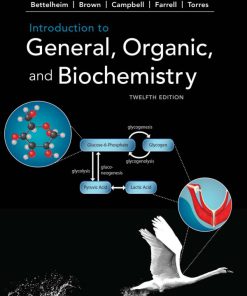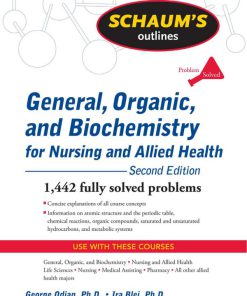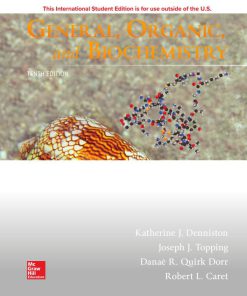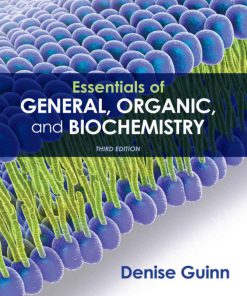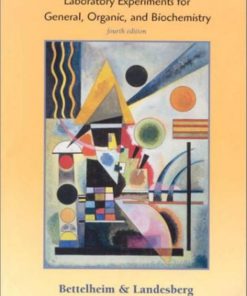General Organic Biochemistry 1st edition by Denniston, Topping, Caret 1266748628 9781266748622
$50.00 Original price was: $50.00.$25.00Current price is: $25.00.
Authors:Denniston K.J., Topping J.J., Caret R.L. , Series:Nursing [63] , Author sort:Denniston K.J., Topping J.J., Caret R.L. , Languages:Languages:eng , Publisher:McGraw Hill
General Organic Biochemistry 1st edition by Denniston, Topping, Caret- Ebook PDF Instant Download/Delivery. 1266748628, 9781266748622
Full download General Organic Biochemistry 1st edition after payment
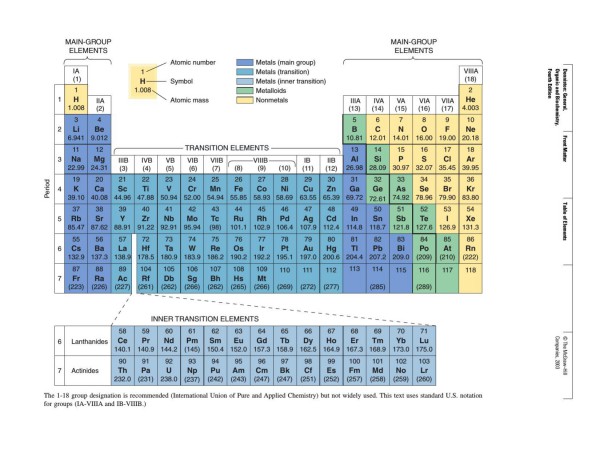
Product details:
ISBN 10: 1266748628
ISBN 13: 9781266748622
Author: Denniston K.J., Topping J.J., Caret R.L.
The eleventh edition of General Organic and Biochemistry offers a problem-solving approach and is designed to help undergraduate majors in health-related fields understand key concepts and appreciate significant connections among chemistry health and the treatment of disease. This new edition is available in ALEKS featuring Virtual Labs Video Assignments the ALEKS Drawing Tool and much more.
General Organic Biochemistry 1st Table of contents:
Chapter 1: Chemistry: Methods and Measurement
1.1. Strategies for Success in Chemistry
1.2. The Discovery Process
1.3. The Classification of Matter
1.4. The Units of Measurement
1.5. The Numbers of Measurement
1.6. Unit Conversion
1.7. Additional Experimental Quantities
Chapter 2: The Structure of the Atom and the Periodic Table
2.1. Composition of the Atom
2.2. Development of Atomic Theory
2.3. Light, Atomic Structure, and the Bohr Atom
2.4. The Periodic Law and the Periodic Table
2.5. Electron Arrangement and the Periodic Table
2.6. Valence Electrons and the Octet Rule
2.7. Trends in the Periodic Table
Chapter 3: Structure and Properties of Ionic and Covalent Compounds
3.1. Chemical Bonding
3.2. Naming Compounds and Writing Formulas of Compounds
3.3. Properties of Ionic and Covalent Compounds
3.4. Drawing Lewis Structures of Molecules and Polyatomic Ions
3.5. Properties Based on Molecular Geometry and Intermolecular Forces
Chapter 4: Calculations and the Chemical Equation
4.1. The Mole Concept and Atoms
4.2. The Chemical Formula, Formula Mass, and Molar Mass
4.3. The Chemical Equation and the Information It Conveys
4.4. Balancing Chemical Equations
4.5. Precipitation Reactions
4.6. Net Ionic Equations
4.7. Acid-Base Reactions
4.8. Oxidation-Reduction Reactions
4.9. Calculations Using the Chemical Equation
Chapter 5: States of Matter: Gases, Liquids, and Solids
5.1. The Gaseous State
5.2. The Liquid State
5.3. The Solid State
Chapter 6: Solutions
6.1. Properties of Solutions
6.2. Concentration Based on Mass
6.3. Concentration Based on Moles
6.4. Concentration-Dependent Solution Properties
6.5. Aqueous Solutions
Chapter 7: Energy, Rate, and Equilibrium
7.1. Thermodynamics
7.2. Experimental Determination of Energy Change in Reactions
7.3. Kinetics
7.4. Equilibrium
Chapter 8: Acids and Bases and Oxidation-Reduction
8.1. Acids and Bases
8.2. pH: A Measurement Scale for Acids and Bases
8.3. Reactions between Acids and Bases
8.4. Acid-Base Buffers
8.5. Oxidation-Reduction Processes
Chapter 9: The Nucleus, Radioactivity, and Nuclear Medicine
9.1. Natural Radioactivity
9.2. Writing a Balanced Nuclear Equation
9.3. Properties of Radioisotopes
9.4. Nuclear Power
9.5. Medical Applications of Radioactivity
9.6. Biological Effects of Radiation
9.7. Measurement of Radiation
Chapter 10: An Introduction to Organic Chemistry: The Saturated Hydrocarbons
10.1. Strategies for Success in Organic Chemistry
10.2. The Chemistry of Carbon
10.3. Alkanes
10.4. Cycloalkanes
10.5. Conformations of Alkanes and Cycloalkanes
10.6. Reactions of Alkanes and Cycloalkanes
Chapter 11: The Unsaturated Hydrocarbons: Alkenes, Alkynes, and Aromatics
11.1. Alkenes and Alkynes: Structure and Physical Properties
11.2. Alkenes and Alkynes: Nomenclature
11.3. Geometric Isomers: A Consequence of Unsaturation
11.4. Alkenes in Nature
11.5. Reactions Involving Alkenes and Alkynes
11.6. Aromatic Hydrocarbons
11.7. Heterocyclic Aromatic Compounds
Chapter 12: Alcohols, Phenols, Thiols, and Ethers
12.1. Alcohols: Structure and Physical Properties
12.2. Alcohols: Nomenclature
12.3. Medically Important Alcohols
12.4. Reactions Involving Alcohols
12.5. Oxidation and Reduction in Living Systems
12.6. Phenols
12.7. Ethers
12.8. Thiols
Chapter 13: Aldehydes and Ketones
13.1. Structure and Physical Properties
13.2. IUPAC Nomenclature and Common Names
13.3. Important Aldehydes and Ketones
13.4. Reactions Involving Aldehydes and Ketones
Chapter 14: Carboxylic Acids and Carboxylic Acid Derivatives
14.1. Carboxylic Acids
14.2. Esters
14.3. Acid Chlorides and Acid Anhydrides
14.4. Nature’s High-Energy Compounds: Phosphoesters and Thioesters
Chapter 15: Amines and Amides
15.1. Amines
15.2. Heterocyclic Amines
15.3. Amides
15.4. A Preview of Amino Acids, Proteins, and Protein Synthesis
15.5. Neurotransmitters
Chapter 16: Carbohydrates
16.1. Strategies for Success in Biochemistry
16.2. Types of Carbohydrates
16.3. Monosaccharides
16.4. Stereoisomers and Stereochemistry
16.5. Biologically Important Monosaccharides
16.6. Biologically Important Disaccharides
16.7. Polysaccharides
Chapter 17: Lipids and Their Functions in Biochemical Systems
17.1. Biological Functions of Lipids
17.2. Fatty Acids
17.3. Glycerides
17.4. Nonglyceride Lipids
17.5. Complex Lipids
17.6. The Structure of Biological Membranes
Chapter 18: Protein Structure and Function
18.1. Biological Functions of Proteins
18.2. Protein Building Blocks: The α-Amino Acids
18.3. The Peptide Bond
18.4. The Primary Structure of Proteins
18.5. The Secondary Structure of Proteins
18.6. The Tertiary Structure of Proteins
18.7. The Quaternary Structure of Proteins
18.8. An Overview of Protein Structure and Function
18.9. Myoglobin and Hemoglobin
18.10. Proteins in the Blood
18.11. Denaturation of Proteins
18.12. Dietary Protein and Protein Digestion
Chapter 19: Enzymes
19.1. Nomenclature and Classification
19.2. The Effect of Enzymes on the Activation Energy of a Reaction
19.3. The Effect of Substrate Concentration on Enzyme-Catalyzed Reactions
19.4. The Enzyme-Substrate Complex
19.5. Specificity of the Enzyme-Substrate Complex
19.6. The Transition State and Product Formation
19.7. Cofactors and Coenzymes
19.8. Environmental Effects
19.9. Regulation of Enzyme Activity
19.10. Inhibition of Enzyme Activity
19.11. Proteolytic Enzymes
19.12. Uses of Enzymes in Medicine
Chapter 20: Introduction to Molecular Genetics
20.1. The Structure of the Nucleotide
20.2. The Structure of DNA and RNA
20.3. DNA Replication
20.4. Information Flow in Biological Systems
20.5. The Genetic Code
20.6. Protein Synthesis
20.7. Mutation, Ultraviolet Light, and DNA Repair
20.8. Recombinant DNA
20.9. Polymerase Chain Reaction
20.10. The Human Genome Project
Chapter 21: Carbohydrate Metabolism
21.1. ATP: The Cellular Energy Currency
21.2. Overview of Catabolic Processes
21.3. Glycolysis
21.4. Fermentations
21.5. The Pentose Phosphate Pathway
21.6. Gluconeogenesis: The Synthesis of Glucose
21.7. Glycogen Synthesis and Degradation
Chapter 22: Aerobic Respiration and Energy Production
22.1. The Mitochondria
22.2. Conversion of Pyruvate to Acetyl CoA
22.3. An Overview of Aerobic Respiration
22.4. The Citric Acid Cycle (the Krebs Cycle)
22.5. Control of the Citric Acid Cycle
22.6. Oxidative Phosphorylation
22.7. The Degradation of Amino Acids
22.8. The Urea Cycle
22.9. Overview of Anabolism: The Citric Acid Cycle as a Source of Biosynthetic Intermediates
Chapter 23: Fatty Acid Metabolism
23.1. Lipid Metabolism in Animals
23.2. Fatty Acid Degradation
23.3. Ketone Bodies
23.4. Fatty Acid Synthesis
23.5. The Regulation of Lipid Metabolism
23.6. The Effects of Insulin and Glucagon on Cellular Metabolism
Glossary
Answers to Practice Problems
Answers to Odd-Numbered Questions and Problems
Index
People also search for General Organic Biochemistry 1st :
exercises for the general organic & biochemistry laboratory
introduction to general organic & biochemistry
exploring general organic & biochemistry in the laboratory
achieve essentials for general organic biochemistry access





